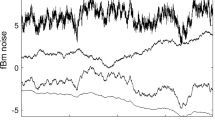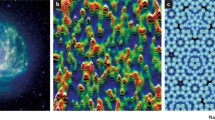Abstract
The natural variability in physiological form and function is herein related to the geometric concept of a fractal. The average dimensions of the branches in the tracheobronchial tree, long thought to be exponential, are shown to be an inverse power law of the generation number modulated by a harmonic variation. A similar functional form is found for the power spectrum of the QRS-complex of the healthy human heart. These results follow from the assumption that the bronchial tree and the cardiac conduction system are fractal forms. The fractal concept provides a mechanism for the morphogenesis of complex structures which are more stable than those generated by classical scaling (i.e., they are more error tolerant).
Similar content being viewed by others
References
Berry, M.V.; Lewis, A.V. On the Weierstrass-Mandelbrot fractal function. Proc. Roy. Soc. Lond. 370A:459–484; 1980.
Goldberger, A.L.; West, B.J. Fractals in physiology and medicine. Yale J. Biol. Med. 60:421–435; 1987.
Goldberger, A.L.; Bhargava, V.; West, B.J.; Mandell, A.J. On a mechanism of cardiac electrical stability; the fractal hypothesis. Biophys. J. 48:525–528; 1985.
Hughes, E.D., Montroll, E.W.; Shlesinger, M.F. J. Stat. Phys. 28:111; 1982.
Koslow, S.H.; Mandell, A.J.; Shlesinger, M.F., eds. Perspectives in biological dynamics and theoretical medicine. New York: New York Acad. Sci.; 1987.
Mandelbrot, B.B. Fractals, form and chance. W.H. Freeman; 1977; The fractal geometry of nature. W.H. Freeman; 1982.
Montroll, E.W. and Shlesinger, M.F., Proc. Natl. Acad. Sci. 79:337; 1982.
Raabe, O.G.; Yeh, M.C.; Schum, G.M.; Phalen, R.F. Tracheobronchial geometry; human, dog, rat, hamster. Albuquerque, NM: Lovelace Foundation for Medical Education and Research; 1976.
Thompson, D.W. On growth and forum, 2nd Ed., Cambridge, England: Cambridge University Press; 1963; original 1917.
Weibel, E.R.; Gomez, D.M. The architecture of the human lung, Sci. 137:577; 1962.
West, B.J. In: Kelso, J.A.S.; Mandell, A.J.; Shlesinger, M.F., eds. Dynamic patterns in complex systems. Singapore: World Science; 1988.
West, B.J.; Bhargava V., Goldberger, A.L. Beyond the principle of similitude: Renormalizaton in the bronchial tree. J. Appl. Physiol. 60:188–197; 1986.
West, B.J.; Goldberger, A.L. Physiology in fractal dimensions. Am. Sci. 75:354–365; 1987.
West, B.J.; Goldberger, A.L.; Rovner, G.; Bhargava, V. Nonlinear dynamics of the heartbeat I. The AV junction: Passive conduit or active oscillator? Physica 17D:198–206; 1985.
Author information
Authors and Affiliations
Rights and permissions
About this article
Cite this article
West, B.J. Physiology in fractal dimensions: Error tolerance. Ann Biomed Eng 18, 135–149 (1990). https://doi.org/10.1007/BF02368426
Issue Date:
DOI: https://doi.org/10.1007/BF02368426




